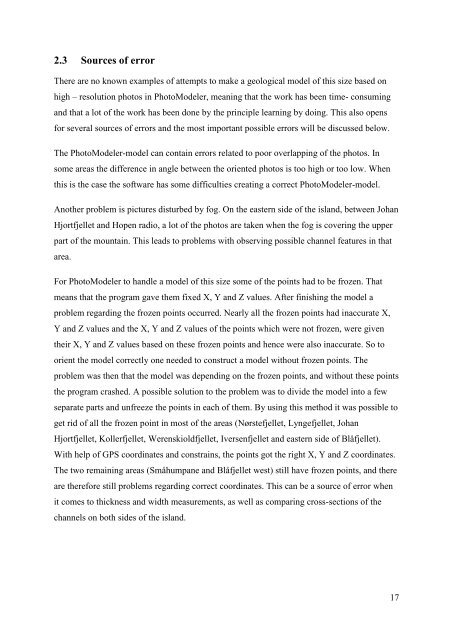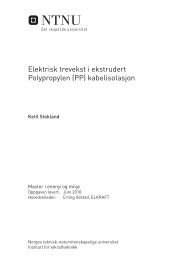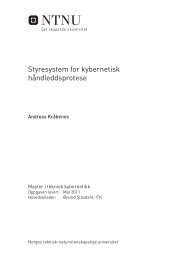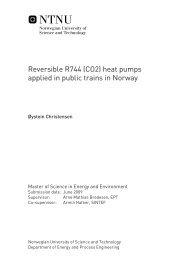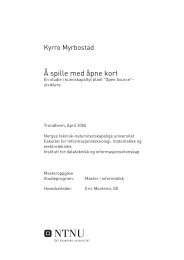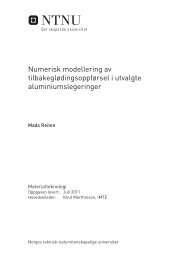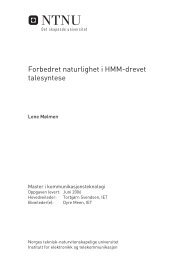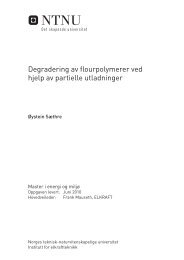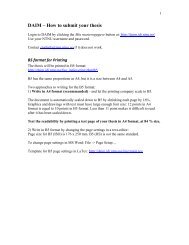Visualize and interpret the geometry, heterogeneity and lateral ...
Visualize and interpret the geometry, heterogeneity and lateral ...
Visualize and interpret the geometry, heterogeneity and lateral ...
You also want an ePaper? Increase the reach of your titles
YUMPU automatically turns print PDFs into web optimized ePapers that Google loves.
2.3 Sources of errorThere are no known examples of attempts to make a geological model of this size based onhigh – resolution photos in PhotoModeler, meaning that <strong>the</strong> work has been time- consuming<strong>and</strong> that a lot of <strong>the</strong> work has been done by <strong>the</strong> principle learning by doing. This also opensfor several sources of errors <strong>and</strong> <strong>the</strong> most important possible errors will be discussed below.The PhotoModeler-model can contain errors related to poor overlapping of <strong>the</strong> photos. Insome areas <strong>the</strong> difference in angle between <strong>the</strong> oriented photos is too high or too low. Whenthis is <strong>the</strong> case <strong>the</strong> software has some difficulties creating a correct PhotoModeler-model.Ano<strong>the</strong>r problem is pictures disturbed by fog. On <strong>the</strong> eastern side of <strong>the</strong> isl<strong>and</strong>, between JohanHjortfjellet <strong>and</strong> Hopen radio, a lot of <strong>the</strong> photos are taken when <strong>the</strong> fog is covering <strong>the</strong> upperpart of <strong>the</strong> mountain. This leads to problems with observing possible channel features in thatarea.For PhotoModeler to h<strong>and</strong>le a model of this size some of <strong>the</strong> points had to be frozen. Thatmeans that <strong>the</strong> program gave <strong>the</strong>m fixed X, Y <strong>and</strong> Z values. After finishing <strong>the</strong> model aproblem regarding <strong>the</strong> frozen points occurred. Nearly all <strong>the</strong> frozen points had inaccurate X,Y <strong>and</strong> Z values <strong>and</strong> <strong>the</strong> X, Y <strong>and</strong> Z values of <strong>the</strong> points which were not frozen, were given<strong>the</strong>ir X, Y <strong>and</strong> Z values based on <strong>the</strong>se frozen points <strong>and</strong> hence were also inaccurate. So toorient <strong>the</strong> model correctly one needed to construct a model without frozen points. Theproblem was <strong>the</strong>n that <strong>the</strong> model was depending on <strong>the</strong> frozen points, <strong>and</strong> without <strong>the</strong>se points<strong>the</strong> program crashed. A possible solution to <strong>the</strong> problem was to divide <strong>the</strong> model into a fewseparate parts <strong>and</strong> unfreeze <strong>the</strong> points in each of <strong>the</strong>m. By using this method it was possible toget rid of all <strong>the</strong> frozen point in most of <strong>the</strong> areas (Nørstefjellet, Lyngefjellet, JohanHjortfjellet, Kollerfjellet, Werenskioldfjellet, Iversenfjellet <strong>and</strong> eastern side of Blåfjellet).With help of GPS coordinates <strong>and</strong> constrains, <strong>the</strong> points got <strong>the</strong> right X, Y <strong>and</strong> Z coordinates.The two remaining areas (Småhumpane <strong>and</strong> Blåfjellet west) still have frozen points, <strong>and</strong> <strong>the</strong>reare <strong>the</strong>refore still problems regarding correct coordinates. This can be a source of error whenit comes to thickness <strong>and</strong> width measurements, as well as comparing cross-sections of <strong>the</strong>channels on both sides of <strong>the</strong> isl<strong>and</strong>.17


